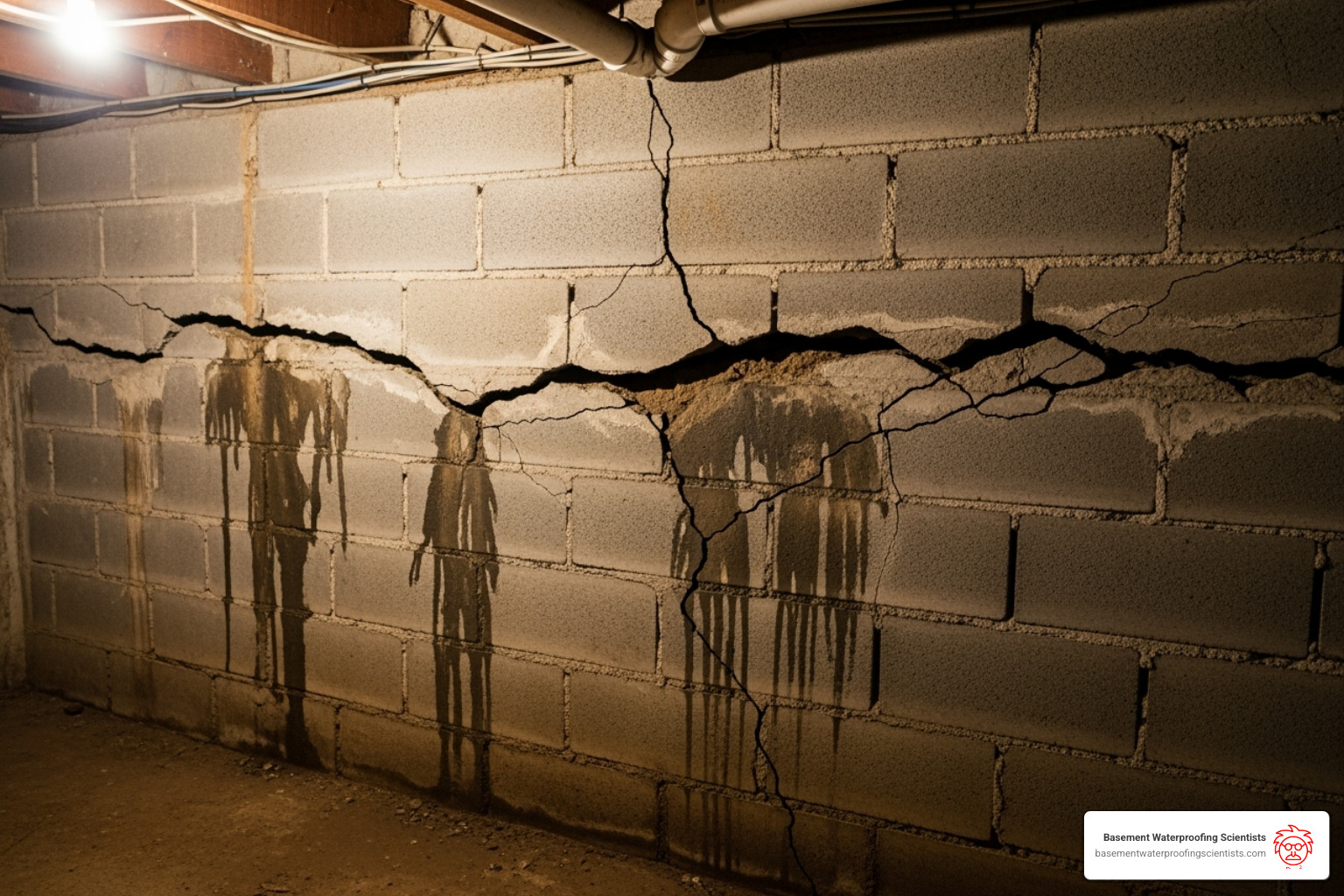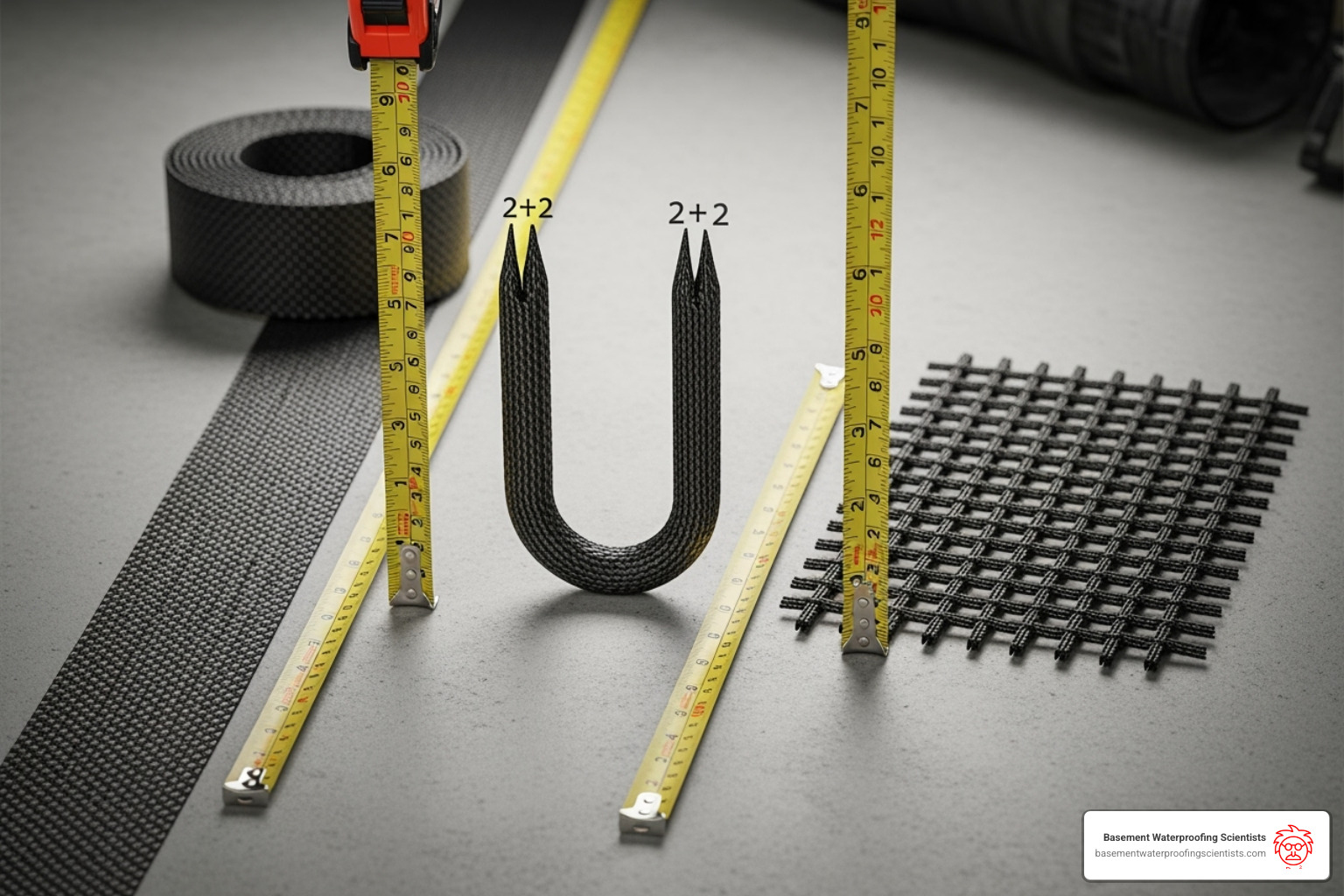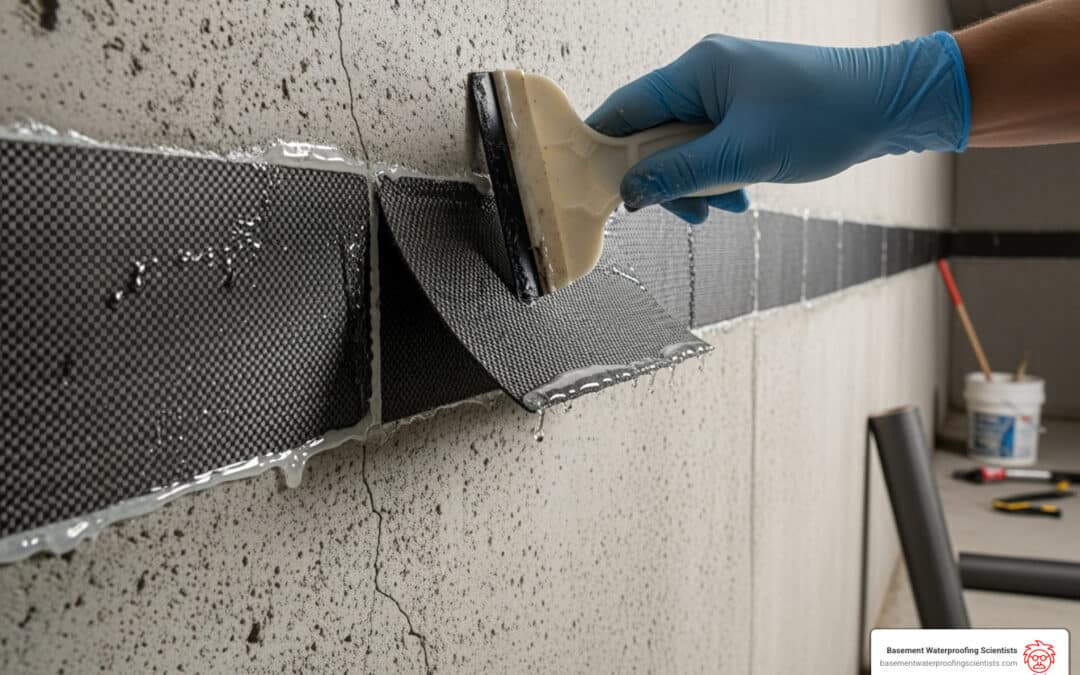What is Carbon Fiber Foundation Repair and Why is it Gaining Popularity?
Carbon fiber foundation repair is a modern solution that uses high-strength carbon fiber materials bonded with structural epoxy to stabilize bowing walls and reinforce foundation cracks. It has become a go-to choice for homeowners for several key reasons.
Key Benefits:
- 10x stronger than steel for superior reinforcement
- Non-invasive installation completed from inside your basement
- No excavation required, saving time and landscaping
- Paintable finish to maintain basement aesthetics
- Permanent solution with lifetime warranty potential
- Cost-effective at approximately $800-$1000 per strap
Best Used For:
- Bowing basement walls (under 2-3 inches)
- Horizontal and stair-step cracks
- Wall stabilization without straightening
- Poured concrete and concrete block foundations
Foundation problems develop when hydrostatic pressure from saturated soil pushes against basement walls, causing them to bow or crack. While traditional methods like steel I-beams require excavation and consume basement space, carbon fiber technology offers a cleaner alternative. The material’s incredible tensile strength—approximately 800,000 psi—allows thin strips to provide the same reinforcement as bulky steel beams.
As one industry expert notes: “Carbon fiber is quickly becoming the go-to choice for repairing cracked and bowing foundation walls” because it addresses structural issues without the invasive installation of older methods.
With over 30 years of experience, my team at Basement Waterproofing Scientists has seen carbon fiber become the industry standard for wall stabilization, helping hundreds of Philadelphia-area homeowners find the right solution for their foundation challenges.

Carbon fiber foundation repair terminology:
- exterior foundation cracks
- fixing exterior foundation cracks
- exterior wall crack repair waterproofing
Understanding the Root Cause: Why Do Basement Walls Bow and Crack?
Basement walls bow or crack when external pressures exceed their structural integrity. The primary culprit is hydrostatic pressure. When heavy rain soaks the ground, the saturated soil expands and exerts immense pressure against the foundation, pushing it inward. This is especially true in areas with expansive soil rich in clay, which swells significantly when wet and shrinks when dry, creating a constant push-and-pull on the foundation.

Other factors contributing to bowed or cracked basement walls include:
- Poor drainage: Improperly routed rainwater saturates the soil next to your foundation, increasing hydrostatic pressure. Well-maintained gutters and downspouts are critical.
- Frost heave: In colder climates, water in the soil freezes and expands, pushing against walls. The subsequent thaw can cause the soil to settle unevenly, creating stress.
- Tree roots: Large tree roots can expand and exert pressure on foundation walls, causing or worsening cracks.
- Vibrations: Nearby construction, heavy traffic, or seismic activity can cause ground vibrations that stress foundation walls.
- Poor construction: If the foundation was not properly designed or built with adequate reinforcement or quality materials, it may be more susceptible to external pressures.
Identifying the root cause is crucial for determining the most effective and long-lasting solution. Understanding these underlying issues is the first step towards a permanent repair. You can learn more about addressing these fundamental issues in our guide: Understanding Structural Basement Repair: What You Need to Know.
A Closer Look at Carbon Fiber Foundation Repair Methods
Carbon fiber is a versatile material that can be applied in different forms to target specific foundation issues. Its incredible strength can be precisely directed where your foundation needs it most.

Let’s explore the different types of carbon fiber materials and their applications:
For Bowing or Leaning Walls: Carbon Fiber Straps
Carbon fiber straps are the primary solution for walls that are bowing, leaning, or showing inward movement. These thin, powerful strips of carbon fiber fabric are bonded directly to the interior surface of the foundation wall with a high-strength structural epoxy.
Once installed, the straps form a rigid composite that resists the external pressure causing the bowing. They act as an internal reinforcement, stopping further inward movement. Their function is to stabilize the wall and distribute pressure evenly across its surface, reducing stress points that lead to bowing and cracking.
Straps are used on both poured concrete and concrete block walls. For optimal results, they are typically anchored at the top (to the rim joist) and bottom (to the basement floor) of the wall. This creates a complete system that prevents the wall from shifting. While carbon fiber straps are excellent at halting movement, they do not push the wall back to its original position. Their main purpose is stabilization. For more information on repair options, explore our guide on 7 Top-Rated Foundation Repair Techniques for Homeowners in 2024.
For Reinforcing Cracks: Carbon Fiber Stitches and Staples
For structural cracks—especially horizontal or stair-step cracks in block walls—we use carbon fiber stitches and staples. These are designed to “stitch” the crack together, restoring the wall’s lost strength.
Carbon fiber stitches are laid across the crack, perpendicular to it. They are embedded in small slots cut into the wall and saturated with structural epoxy. This creates a powerful bond that prevents the crack from widening or moving.
Before applying stitches, we often use an epoxy injection directly into the crack. This seals the crack from water intrusion and creates a solid base for the carbon fiber. The goal is to stop crack growth by adding incredible strength precisely where the wall is weakest, ensuring long-term stability. If you see new or growing cracks, contact us for an assessment. Learn more about our local services on our page: Foundation Crack Repair Near Me.
For Sealing and Minor Reinforcement: Carbon Fiber Fabric and Grids
Beyond heavy-duty applications, carbon fiber also comes in flexible forms like fabric and grids. These are ideal for sealing uneven surfaces or reinforcing a wider area.
After sealing a crack with epoxy injection, we can apply a layer of carbon fiber fabric or a grid over the repair. This adds an extra layer of strength and helps prevent future movement. These materials are also perfect for corner reinforcement, where stress can be concentrated.
Because carbon fiber fabric is flexible, it conforms easily to irregular surfaces, ensuring a solid bond for effective reinforcement. Like other carbon fiber methods, these fabrics and grids are bonded with high-strength structural epoxy. This creates a composite material that is both strong and durable. Systems like FIBERLOCK™ combine a filler to seal the crack with carbon fiber to add tensile strength, significantly reducing the chance of future problems. These systems are useful for reinforcing larger areas or where the wall’s shape makes straps or staples impractical.
Carbon Fiber: The Modern Solution for Foundation Repair
For years, standard repairs for bowing walls involved bulky steel I-beams or exterior wall anchors. While effective, these methods have significant downsides. Carbon fiber foundation repair has revolutionized the field, offering a solution that is incredibly strong, smart, and non-invasive.
Here’s a quick comparison of carbon fiber against older methods:
| Metric | Carbon Fiber Straps | Traditional Steel Reinforcement | Wall Anchors |
|---|---|---|---|
| Strength | 10x stronger than steel (tensile) | Very strong | Strong |
| Invasiveness | Minimal (interior application) | High (exterior excavation often needed) | High (exterior excavation needed) |
| Cost | Often more cost-effective ($800-$1000/strap) | More expensive | Varies, can be comparable or higher |
| Usable Space | Virtually no loss | Significant loss (protruding beams) | Minimal interior protrusion |
| Aesthetics | Paintable, nearly invisible | Visible, bulky | Visible plates/hardware |
| Maintenance | No maintenance | Minimal (check for rust) | Occasional tightening/adjustment |
Why Choose Carbon Fiber Foundation Repair?
At Basement Waterproofing Scientists, we aim to find the most effective, least disruptive, and longest-lasting solution. Carbon fiber foundation repair frequently meets these criteria.
First, its strength is exceptional. Carbon fiber is 10 times stronger than steel by tensile strength. A thin, unobtrusive strap provides superior reinforcement compared to a heavy steel beam. This strength-to-weight ratio, also used in aerospace and racing, allows for a quicker, less complex installation.
One of the biggest advantages is the minimal intrusion and no excavation requirement. The repair is done almost entirely from inside your basement, meaning no disruption to your landscaping or yard. This makes for a smoother, faster process and is ideal for properties with limited exterior access.
Once installed, carbon fiber is a permanent, maintenance-free part of your foundation. It requires no maintenance as it won’t rust, corrode, or degrade. For those planning a finished basement, the paintable finish is a major benefit. The low-profile straps lay nearly flat against the wall and can be painted to match your decor or covered with drywall. This durability ensures a long-lasting, worry-free repair. To avoid common pitfalls, see our guide: Don’t Let These Foundation Repair Mistakes Damage Your Home.
Limitations of Older Foundation Repair Methods
While steel I-beams and wall anchors have their place, they come with significant drawbacks.
A primary concern is the loss of usable square footage. Steel I-beams are bulky, protruding several inches from the wall and consuming valuable floor space, which is a major issue if you plan to finish your basement.
The intrusive installation is another problem. Both steel beams and wall anchors often require exterior excavation, which means digging trenches that can damage landscaping, driveways, and utilities. It’s a messy, disruptive process.
Finally, steel is susceptible to rust in damp basement environments, which can weaken the beams and stain walls. From an aesthetics standpoint, exposed steel beams and exterior wall anchor plates are often considered unsightly. These limitations are why we frequently recommend advanced, homeowner-friendly solutions like carbon fiber foundation repair.
The Nitty-Gritty: Installation, Cost, and Long-Term Performance
Let’s cover the practical details of carbon fiber foundation repair: the installation process, expected costs, and long-term performance.

The Carbon Fiber Foundation Repair Process Step-by-Step
Our approach is meticulous to ensure a strong, lasting bond and effective stabilization. Here is a typical overview:
- Wall Preparation: This is a crucial first step. We thoroughly clean the foundation wall, removing dirt, paint, or loose debris. We then grind the surface where the carbon fiber will be applied to create a rough texture for optimal epoxy adhesion.
- Crack Injection: If cracks are present, we inject a high-strength epoxy resin to fill and seal them. This prevents moisture intrusion and provides a solid base for reinforcement.
- Applying Structural Epoxy: A specialized epoxy adhesive is spread onto the prepared wall surface.
- Placing the Carbon Fiber: Pre-cut carbon fiber straps or sheets are pressed onto the epoxy, ensuring they are straight and free of air bubbles. For straps, proper top and bottom anchoring is included to maximize effectiveness.
- Curing Process: An additional layer of epoxy may be applied to fully saturate the carbon fiber. The epoxy typically cures in 24-48 hours. Once cured, the carbon fiber is a permanent part of your wall, ready to resist external forces. For more details on our approach, visit our page on Foundation Repair in PA.
How Much Does It Cost?
Cost is a significant factor for any homeowner. Carbon fiber foundation repair is typically priced on a per-strap basis, with costs generally ranging from $800-$1000 per strap. This accounts for material, labor, and installation complexity.
The total cost depends on the project scope, specifically the number of straps needed to stabilize the wall. For example, a 24-foot wall might require 5 straps, for an estimated total of $3,625–$4,000. Costs can vary slightly by geographic location in our service areas of Pennsylvania, New Jersey, and Delaware.
While the per-strap cost is notable, carbon fiber foundation repair is generally less expensive than traditional methods like steel I-beams or repairs requiring extensive excavation. This is due to reduced labor, less intrusive installation, and no need for heavy equipment. We always provide a detailed, transparent estimate after a thorough inspection.
Lifespan and Maintenance
One of the most appealing aspects of carbon fiber foundation repair is its longevity and minimal maintenance. This is a permanent fix, not a temporary patch.
Once bonded to the wall, it becomes a permanent solution. Carbon fiber has an indefinitely long lifespan and will not stretch or degrade under normal conditions, likely outlasting the building itself. Many reputable systems, including those we use, come with robust warranties, offering lifetime warranty potential. We often back our structural repairs with a lifetime guarantee, so you can have peace of mind.
The best part is that no ongoing maintenance is required once the epoxy has cured. It doesn’t need tightening or adjustments. While the repair is maintenance-free, we recommend periodic visual inspection of your basement for any new issues as part of good homeownership practice.
Finally, it’s critical to maintain proper moisture control around your foundation. While carbon fiber is strong, prolonged moisture can affect the epoxy bond or indicate a larger water issue that needs to be addressed. This is where our expertise as Basement Waterproofing Scientists is key—addressing water issues proactively protects all your foundation repairs.
When Is Carbon Fiber NOT the Right Solution?
While carbon fiber foundation repair is an excellent solution for many foundation issues, no single method is right for every problem. Our priority is to correctly diagnose your home’s situation and recommend the most appropriate fix, even if it isn’t carbon fiber.
Here are some scenarios where carbon fiber foundation repair may not be the best choice:
-
Severe Bowing or Shearing: If a basement wall has bowed inward more than 2-3 inches, carbon fiber may not be sufficient. It is designed to stop future movement, not to push a severely bowed wall back to its original position. For these cases, methods like steel I-beams or wall anchors, which may require excavation, might be needed to realign the wall. Similarly, if a wall has sheared or slid from its base, a more complex structural repair is required.
-
Deteriorated Foundation: The success of carbon fiber repair depends on a strong bond with the existing foundation. If the concrete or masonry is crumbling, spalling, or otherwise deteriorated, the epoxy will not have a stable surface to adhere to. In these situations, sections of the wall may need to be rebuilt or reinforced before carbon fiber can be considered. Additionally, carbon fiber systems are designed for poured concrete and concrete block (CMU) walls, not older stone or brick foundations which have different properties.
-
Active Water Intrusion: While carbon fiber is impervious to water, the epoxy resin used to bond it can be sensitive to long-term moisture. Industry guidelines (ACI Committee Report 440.2R-02) advise against applying these systems to surfaces with ongoing moisture vapor transmission. If your basement walls are constantly wet, the underlying water problem must be addressed first. A persistent moisture issue could compromise the repair and may void manufacturer warranties. Carbon fiber foundation repair is a structural solution, not a waterproofing one.
-
Inadequate Internal Reinforcement: Caution is advised when using carbon fiber as the sole reinforcement for walls built without adequate internal rebar. Adding only surface-bonded reinforcement to a poorly designed wall could lead to a sudden “brittle failure” without warning signs. It is often best used to strengthen under-reinforced walls.
Getting a professional assessment from true Foundation Experts is critical. We understand the stringent guidelines set by organizations like the ICC (International Code Council) and ensure any recommended solution is effective, safe, and compliant.
Frequently Asked Questions about Carbon Fiber Repairs
It’s natural to have questions about your home’s foundation. We get asked a lot about carbon fiber foundation repair, and we’re always happy to share what we know. Here are some of the most common questions we hear:
How long does the installation take?
Most carbon fiber foundation repair jobs, including straps or stitches, can be completed in a single day. The exact time can vary based on the number of repairs needed and the amount of wall preparation required, but our experienced crews work efficiently to minimize disruption.
Will the repairs be visible when I want to finish my basement?
No, and this is a key advantage of carbon fiber foundation repair. The straps and stitches are very low-profile, lying nearly flat against the wall. Once the repair is done, they can be painted to blend in or easily covered with framing and drywall, making them invisible in a finished basement without any loss of square footage.
Do carbon fiber repairs actually straighten the wall?
This is an important distinction. Carbon fiber foundation repair is designed to stabilize the wall and prevent any further inward movement. It acts as a permanent brace to secure your foundation.
However, carbon fiber does not push the wall back to its original, straight position. Its purpose is to permanently stop the bowing or cracking from getting worse. If straightening the wall is the primary goal, other methods may be required, which we would discuss during our inspection.
Secure Your Home’s Future with the Right Foundation Fix
Dealing with your home’s foundation can be overwhelming, but choosing the right solution doesn’t have to be. Carbon fiber foundation repair has emerged as a powerful, non-invasive, and durable way to tackle common basement wall problems. Its superior strength, clean installation, and long-term stability make it a standout choice in modern foundation repair.
We understand that foundation problems are stressful. That’s why our team at Basement Waterproofing Scientists is here to deliver peace of mind. With 30 years of experience, we are experts in keeping basements dry and structurally sound. We provide expert inspections, fair pricing, and a lifetime guarantee. We use specialized tools to pinpoint leak sources, allowing us to fix the root cause of your foundation issues efficiently and for less.
Don’t let cracks or bowing walls compromise your home’s safety and value. It’s time to take action. For a comprehensive evaluation and a permanent solution to your foundation problems, we invite you to explore our basement wall crack repair services. We proudly serve homeowners across Pennsylvania, New Jersey, and Delaware, including communities like Philadelphia, Reading, Norristown, and Pottstown. Let us partner with you to secure your home’s future with a reliable, scientifically sound repair.


